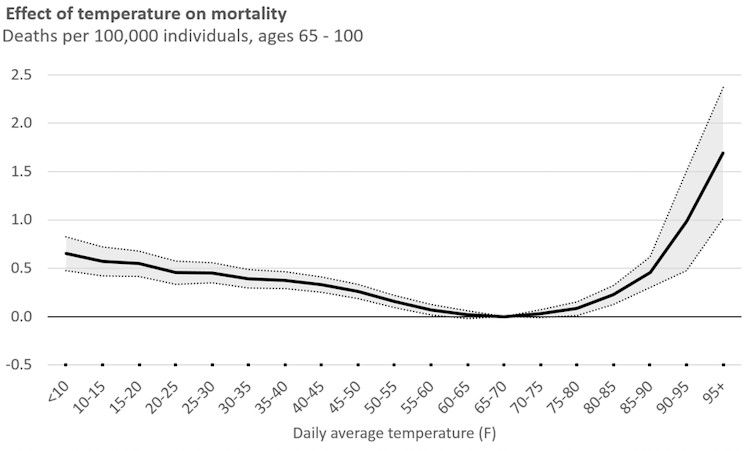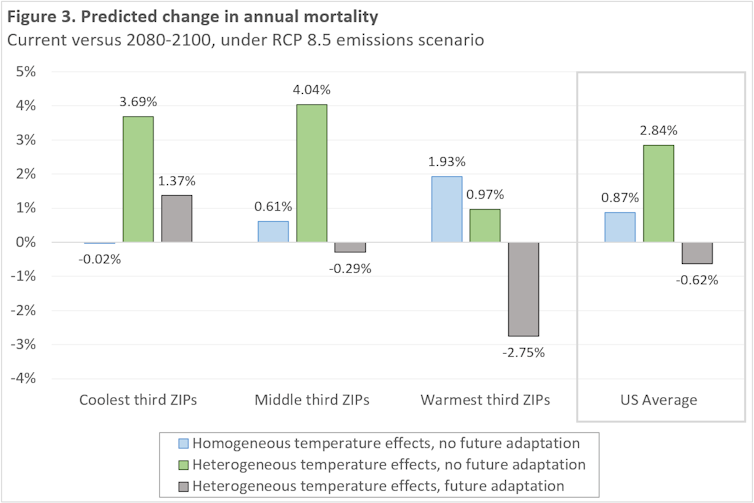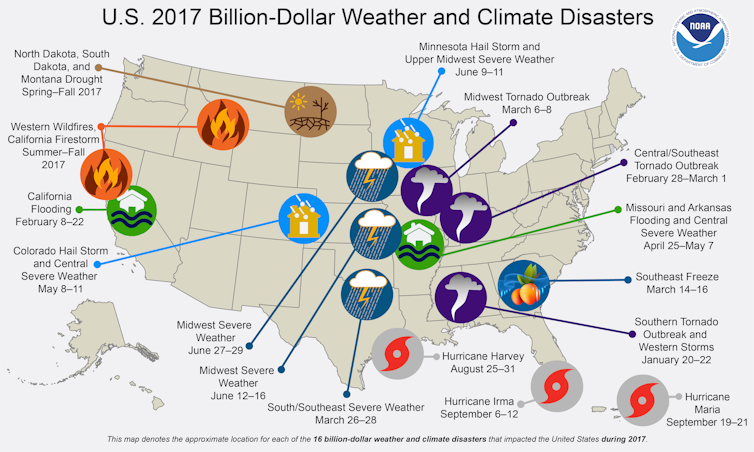Climate change and weather extremes: Both heat and cold can kill
By Garth Heutel, Assistant Professor of Economics, Georgia State University; David Molitor, Assistant Professor of Finance, University of Illinois at Urbana-Champaign; Nolan Miller, Professor of Finance and Julian Simon Faculty Fellow, University of Illinois at Urbana-Champaign
Climate change is increasing the frequency and strength of some types of extreme weather in the United States, particularly heat waves. Last summer the U.S. Southwest experienced life-threatening heat waves, which are especially dangerous for elderly people and other vulnerable populations.
More recently, record-setting cold temperatures engulfed much of the country during the first week of 2018. This arctic blast has been blamed for dozens of deaths. Some scientists believe that Arctic warming may be a factor in this type of persistent cold spell, although others question this connection.
In a recent working paper, we studied the effect of temperature extremes on elderly mortality, using comprehensive data from Medicare covering about 35 million beneficiaries. Analyzing daily patterns at the ZIP code level, we estimated how daily temperature changes affect elderly mortality as a way to predict how people may adapt to climate change.
Our key finding is that both heat waves and cold snaps increase mortality rates. For example, the mortality rate from a day with average temperatures between 90 and 95 degrees Fahrenheit is higher by about 1 death per 100,000 individuals than a day with an average temperature between 65 and 70 degrees. Deaths also increase, by about one-half per 100,000 individuals, on days when the average temperature is less than 20 degrees.
Several prior studies have found similar results. This means that communities need to plan for the higher risk of deaths from both hot and cold weather extremes.

Shivering in Florida, sweating in North Dakota
People and communities have many options for adapting to climate change. They can install air conditioning, or change the urban environment – for example, by planting trees to cool city streets. They may improve readiness at health care facilities, or modify public health strategies – for example, by raising public awareness of risks associated with extreme weather.
As regions adapt, one might suspect that hot places like Miami deal well with heat but struggle with cold, while cold places like Fargo, North Dakota, are ready for deep freezes but less prepared for heat waves. This is exactly the pattern we found when we separately analyzed the hottest, middle, and coldest thirds of all U.S. ZIP codes.
In hot places like Miami, cold days have a very large impact on mortality, while the impact of hot days is smaller. In contrast, hot days in Fargo have a very large impact on mortality, but an additional cold day has little effect. In fact, the effect of the hottest days (90 degrees or higher) in the coldest places is about two to three times larger than the effect of the coldest days (less than 20 degrees) in the hottest places.

Adaptation predictions
Next we considered how people and communities may adapt as climate change intensifies. We used predictions of temperatures in 2080-2100 from a set of climate models called the Coupled Model Intercomparison Project Phase 5, which uses 21 different climate models and assumes that global carbon emissions continue to rise through the end of the century.
Using these projections, we predicted how many extra deaths would be caused by temperature extremes across our hot, moderate and cold zones under three different assumptions.
-
First, we assumed that no future adaptation occurred and that temperature had the same effect on mortality in all regions of the country.
-
Second, we assumed that no future adaptation took place, but that temperature had a different effect on mortality for each ZIP code.
-
Lastly, we assumed that temperature effects on mortality varied and that communities took steps to adapt to climate change. We did not explicitly model specific adaptation strategies; instead, we used the current differences in temperature effects across regions to predict future responses to climate change. Roughly, if Chicago’s future climate starts to resemble current conditions in Miami, then we expect temperature effects on mortality in Chicago to begin mirroring the effects we see now in Miami, as Chicago employs better strategies to cope with high temperature extremes.

In our first scenario, with no adaptation and uniform temperature effects, we found that climate change would increase death rates in the hottest regions by about 2 percent, but would reduce death rates in the coldest regions by a tiny 0.02 percent. This outcome supports the logical expectation that global warming could be less harmful or even beneficial for cold places, since it will reduce the number of very cold days.
Recall that in reality, however, cold regions deal well with cold weather but are less able to deal with extreme heat. In our second scenario, with no adaptation and temperature effects varying by region, we found that warming would increase deaths everywhere. Cold places would experience fewer very cold days, but they would experience more very hot days, for which they are not adapted. Consequently, we estimated that deaths would rise by about 3.7 percent in the coldest regions.
On the other hand, very hot places would see smaller mortality increases in this scenario. Hot places are harmed less than cold places by additional hot days, and benefit more from experiencing fewer cold days than the national average would suggest. In the net, we estimate that deaths due to weather extremes would increase in the hottest places by only 0.97 percent.
Finally, in our third scenario, which allowed for future adaptation to global warming, we found that mortality rates from extreme temperatures decreased for the middle and hottest regions and for the United States overall. This result indicates that when people and communities are allowed to adapt fully to temperature increases, they will do so in ways that more than offset the negative effects of climate change.

Is adaptation the answer?
Taken at face value, these simulations suggest that we don’t need to worry about harmful effects of climate change on elderly mortality, because we can adapt through steps such as installing air conditioning and setting up short-term emergency shelters such as warming centers. But this conclusion would be overly optimistic for several reasons.
First, our study ignores the costs of adapting. Steps such as weatherizing homes can be expensive for both individuals and governments. President Donald Trump’s 2018 budget request proposed eliminating the Department of Energy’s Weatherization Assistance Program, which helps increase the energy efficiency of low-income homes.
Second, our results do not consider other possible policy responses, such as action to reduce greenhouse gas emissions or geoengineer the climate, which may be more effective than relying on adaptation alone.
Our results suggest that there is room for steps that could substantially reduce heat-related elderly mortality due to climate change. Whether to take those steps is a social and political decision. But Americans should consider the temperature extremes that our nation has experienced over the past year as they weigh these choices.